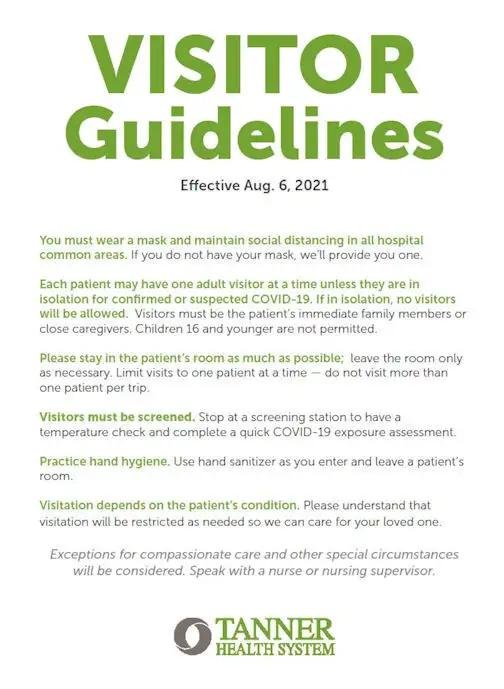Visiting a loved one in the hospital can be a crucial step in thier healing process, offering emotional support and companionship during a challenging time.However, many people may find themselves unsure about visitation policies, especially considering recent changes prompted by health and safety concerns. Understanding how many people can visit a patient and the guidelines that facilities have in place is essential not only for compliance but also to ensure that your visit is supportive and uplifting.
This article serves as an essential guide to navigating hospital visitation rules, helping you balance your desire to be there for your loved one with the hospital’s requirements. We will explore not only the general policies commonly found in healthcare facilities but also the reasons behind thes rules,including patient care considerations and infection control measures. Whether you’re planning your first visit or looking to connect with multiple family members, this guide will provide you with the knowledge you need to make the most of your time together while respecting the hospital’s protocols.
Understanding Visitor Policies in hospitals for Optimal Patient Experience
Visitor policies in hospitals are crucial for ensuring the comfort and safety of patients, enhancing their overall experience during their stay. Each hospital may establish unique guidelines based on their capacity, patient needs, and health regulations. When planning to visit a loved one, it’s crucial to keep in mind the various factors that contribute to these policies, such as:
- Patient Health Status: Depending on the condition of the patient, there may be limits on the number of visitors allowed in the room.
- Infection Control: During critical times, such as flu season or pandemics, hospitals may enforce stricter visitation rules to protect vulnerable patients.
- Time restrictions: Some facilities may have designated visiting hours to ensure that patients receive adequate rest and care.
- Visitor Registration: Certain institutions require visitors to check in at the front desk or provide identification, which helps maintain security and monitor the movement within the hospital.
It’s advisable to check with the hospital directly or visit their website for the most current visitor policies, as these can vary significantly between different institutions. For instance,hospitals might allow:
| Visitor Type | Typical Allowance |
|---|---|
| Immediate Family | 2-3 Visitors |
| Close friends | 1-2 Visitors |
| Children | Varies by hospital |
By understanding these visitor policies,not only can you ensure a smoother visit,but you can also support the patient’s recovery process,contributing positively to their experience at the hospital.Being informed about these guidelines will allow you to better plan your visits and stay connected with the loved ones you care about while they are undergoing treatment.
fostering Emotional Support Through Thoughtful Visiting Practices
During hospital visits, it’s crucial to prioritize emotional support in a way that respects both the patient and the hospital habitat. Thoughtful visiting practices can make all the difference in boosting a patient’s spirit and aiding in their recovery. Here are some considerations to keep in mind:
- Limit Visit Duration: Short, heartfelt visits can prevent overwhelming patients and allow them to rest.
- Timing is Everything: Choose visiting hours wisely, keeping in mind the patient’s treatment schedule and peak rest times.
- Respect Boundaries: Familiarize yourself with hospital policies regarding visitor limits and patient comfort zones to ensure a supportive atmosphere.
- Encourage Positive Interactions: Share uplifting stories or memories that may bring a smile to the patient’s face.
- Stay Attuned: Notice the patient’s mood; if they seem tired or irritable,be prepared to adjust your visit accordingly.
Implementing these practices can enhance the emotional well-being of patients and their families. Moreover, it fosters an environment were healing can thrive, allowing them to feel less isolated during their hospital stay. Understanding the importance of emotional support in the recovery process is key for both visitors and healthcare providers. When shared thoughtfully, these moments of connection can transform a challenging experience into one filled with compassion and love, thereby making a notable positive impact on a patient’s emotional health.
Here’s a simple overview of the best visiting practices:
| Practice | Description |
|---|---|
| Visit Quality | Ensure visits are meaningful and supportive. |
| Frequency | Maintain a balance; avoid overcrowding the patient. |
| preparation | Bring small tokens or thoughtful gifts to brighten their day. |
By implementing these strategies, we can foster a supportive environment that helps patients feel connected and cared for, turning their hospital experience into one that not only focuses on physical healing but also nurtures their emotional well-being.
understanding the visiting policies of hospitals is vital for both patients and their loved ones. While these guidelines may vary from one facility to another, they are designed to foster a healing environment while ensuring the safety and well-being of all. By being informed and respectful of visitation rules, you can play a significant role in supporting a patient’s recovery. Remember, kindness and compassion are the best gifts you can offer during such challenging times. Stay connected and engaged, as your presence can make a world of difference in their healing journey.
